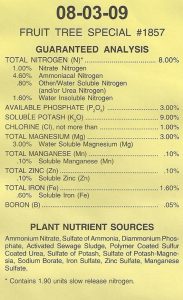When it comes to your landscape, growing fruit trees is different from most of the other plants in your yard because you have a concrete goal—to produce fruit. In order to reach this goal, you need your trees to be in the best shape possible. A tree won’t be able to produce fruit if it is sick or malnourished. You also need to make sure your trees are not growing too vigorously due to over fertilization. Too much fertilizer will force your trees to put all their energy into their leaves and not produce fruit.

The best way to make sure your fruit trees are healthy is to put them on a regular fertilizer schedule. The numbers on a fertilizer bag stand for the percentage of nitrogen, phosphorus and potassium (N-P-K). Therefore, a bag labeled 8-3-9 would be highest in potassium, which is the nutrient most needed by fruit trees. Most fruit trees do well with an 8-3-9 formulation applied lightly around the drip line two to three times a year in the growing/rainy season (late May to late October). Remember not to over fertilize fruit trees, especially with nitrogen, or your trees may only grow vegetatively. Too much nitrogen equals too many leaves and not enough fruit.
Minor elements like boron, copper, zinc and manganese are very important to fruit trees and should be applied several times as a foliar spray during the rainy season. South Florida’s soil is primarily limestone which makes it difficult for minor elements to be taken up by the roots of hungry trees. This is because the elements are bound by the limestone’s high pH and cannot easily be absorbed or moved. Foliar sprays deliver the nutrients directly to the plant and avoid being bound in the soil.
The minor element iron is also important to fruit trees and is best applied as a chelated drench to a tree’s feeder root system which is found around the tree’s drip line. Iron needs to be chelated so it will not get bound in our high pH soil and although it can be applied as a foliar spray, it will not be available in the proper quantity unless it is applied as a drench.
In addition to keeping your trees on a fertilizer schedule, proper watering is also important for tree health. South Florida’s ample rain provides our fruit trees with all the water they need in most cases. Irrigation may be used sparingly if you feel your trees are drying out, but simply watering with a hose a few times during the dry months (November to early May) should be enough. Mangos, lychees and longans actually do best when presented with a drought stress, because the lack of water, along with cooler temperatures, helps to initiate bloom. Too much irrigation can be a real problem with fruit trees and can lead to root rot and other types of fungal diseases. If your fruit tree is in the middle of an irrigated lawn, try to limit the amount of water the tree gets by capping or diverting any sprinkler heads near the tree.
When your fruit trees receive optimal nutrition and water, you have the best chance of producing a crop. By following these tried and tested practices, you should be well on your way to fruiting success.
 2
2
